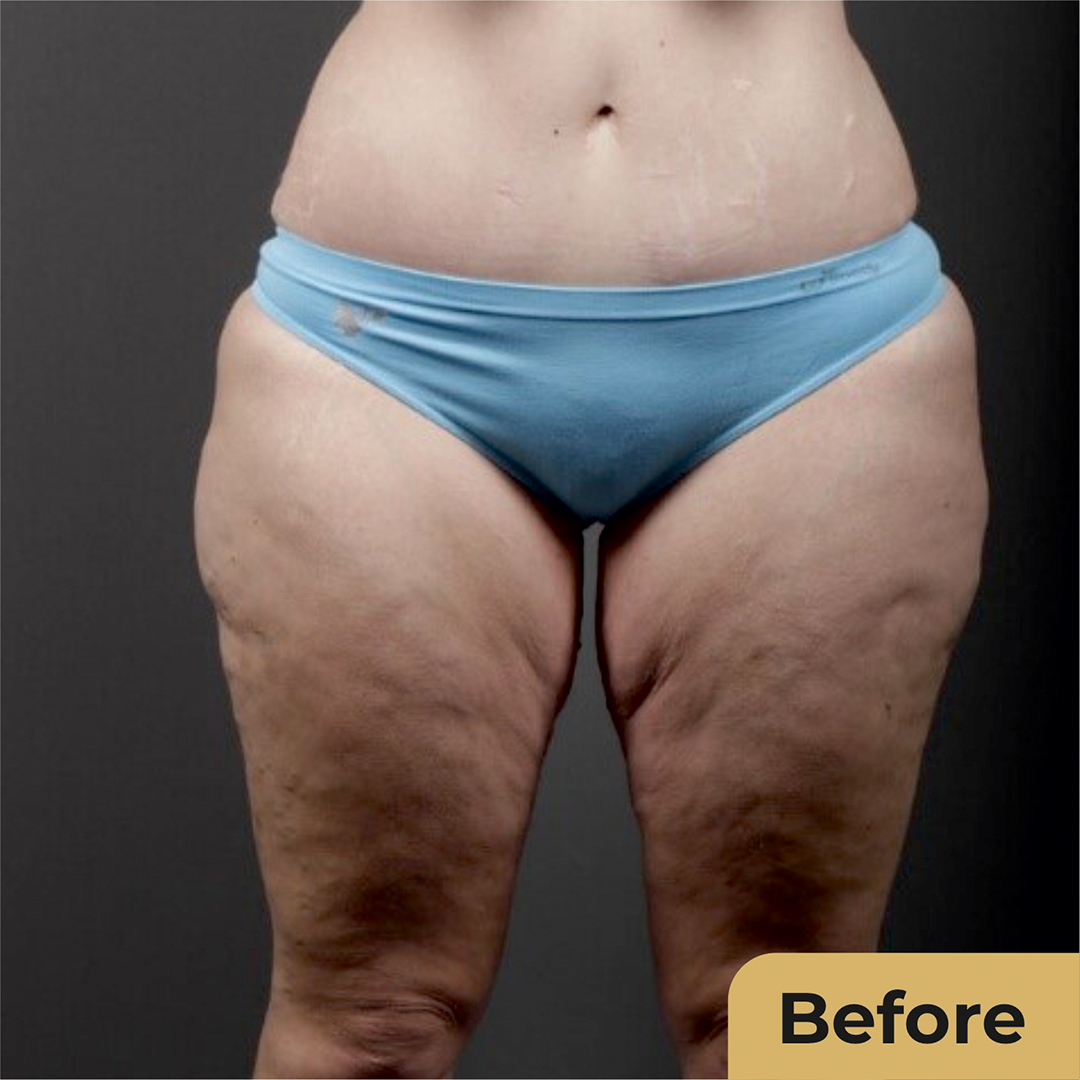
Thigh Lift Surgery in Vadodara

A thigh lift is a cosmetic surgery that reshapes and firms the thighs by removing excess skin and fat, enhancing their tone and contour. It is ideal for individuals who struggle with loose skin or stubborn fat in the thigh area that doesn’t respond to diet or exercise. Unlike procedures focused solely on fat reduction, a thigh lift improves skin elasticity and creates a balanced, sculpted body profile. This surgery helps achieve firmer, more youthful-looking thighs and boosts overall body confidence.
Thigh lift surgery is ideal for men and women seeking to improve the appearance of their thighs after significant weight loss, pregnancy, or due to aging-related skin laxity. You may be a good candidate if you:
- Have loose, sagging skin on your thighs
- Struggle with stubborn fat deposits that do not respond to diet and exercise
- Desire firmer, more contoured thighs
- Are in good overall health and maintain a stable weight
- Have realistic expectations about the results
- It is important to note that thigh lift surgery is not a weight loss solution but a body contouring procedure designed to refine your silhouette and boost self-confidence.
Proper preparation ensures the best possible results from your thigh lift surgery in Vadodara. Follow these key steps:
- Avoid smoking and anti-inflammatory drugs for at least six weeks before surgery to promote proper healing.
- Your surgeon will ensure your weight is stable and may conduct medical evaluations.
- Stay well-hydrated in the days leading up to surgery.
- Prepare for initial post-surgery recovery, as the treated area will be delicate.
- Commit to regular follow-ups with your surgeon. Maintain results through a balanced diet and consistent exercise.
Following these guidelines will help you achieve optimal body contouring results with minimal thigh lift side effects and a smooth recovery time.
A thigh lift surgery typically begins with a detailed consultation at Krisha Hospital, where your surgeon will evaluate your anatomy and body contouring goals. On the day of the procedure, you will be placed under general anesthesia to ensure complete comfort.
The surgeon will make precise incisions—their placement depends on the extent of correction needed. Common approaches include incisions in the inner thigh, groin crease, or along the outer thigh for larger contouring. Through these incisions, the surgeon will remove excess skin and fat, often combining the procedure with liposuction to refine the contours further. The remaining skin is then repositioned and tightened to create a smoother, firmer thigh appearance.
Once the incisions are closed, compression garments may be applied to support healing and minimize swelling. The entire procedure usually takes a few hours, and most patients can return home the same day to begin their recovery journey toward more sculpted, toned thighs.
While thigh lift surgery is generally safe when performed by an experienced surgeon at a reputable clinic like Krisha Hospital, Vadodara, it is important to understand potential risks and safety considerations.
Common risks include swelling, bruising, temporary numbness, and scarring along the incision lines. Some patients may experience infection, fluid accumulation (seroma), or delayed wound healing. Rarely, complications such as blood clots or anesthesia-related reactions may occur.
Choosing the best thigh lift clinic in Gujarat and following pre- and post-surgery guidelines significantly reduces these risks. Our surgeons carefully assess your medical history, ensure proper surgical technique, and provide detailed aftercare instructions to promote a smooth, safe recovery. Maintaining regular follow-ups, staying hydrated, and avoiding smoking further enhances your overall safety and surgical outcome.
The recovery period for thigh lift surgery usually takes about 4 to 6 weeks. During the first two weeks, patients may experience swelling, bruising, and discomfort, which gradually improve with proper care. It’s important to rest and avoid strenuous activities during this time.
Most people can return to light daily activities within 1 to 2 weeks, but full recovery—including resuming exercise and more intense physical activities—typically takes around 4 to 6 weeks. Wearing compression garments as advised by the surgeon helps reduce swelling and supports healing.
Regular follow-up appointments are essential to monitor progress and ensure a smooth recovery. Following your surgeon’s instructions carefully will lead to the best results and minimize complications.
Thigh lift surgery helps to firm and tone the thighs by removing excess skin and fat, resulting in a smoother, more contoured appearance. Patients typically see a noticeable improvement in the shape and firmness of their thighs, which enhances overall body proportions and boosts confidence. The results are usually long-lasting, especially when combined with a healthy lifestyle including diet and exercise. While some scars will remain, they generally fade over time and can be placed in less visible areas.
Overall, thigh lift surgery offers a significant improvement in thigh contour and skin tightness, helping patients feel more comfortable and confident in their bodies.
Our Results



EXCELLENTTrustindex verifies that the original source of the review is Google. Krisha hospital ma me brest size mate consulting karyu d .r rajnikant sir jode Mane ghanu saru samjavyu chhe thanks sirPosted onTrustindex verifies that the original source of the review is Google. Me krisha hospital ma hair fall ni treatment lidhi chhe mane ghanu saru result madiyu chhe thanks for krisha hospitalPosted onTrustindex verifies that the original source of the review is Google. Very nice Krisha Hoshpital na all's Sister and Doctor Rajanikant parmar aap shau a mane bahuj sharsh halp Sarwish aapi mane Pahela karta atiyare bahuj sharu fil thay che Thank u so much doctor &shatap Shalam che tamne Doctor Rajanikant shahenPosted onTrustindex verifies that the original source of the review is Google. Really happy with service. One of the best clinicPosted onTrustindex verifies that the original source of the review is Google. Amazing worked on my face by rajnikant sir.. I have many stitches on my face but after recovery no marks on my face.. Thank you very much..Posted onTrustindex verifies that the original source of the review is Google. Krisha hospital me mene skin glow ke liye haydra facial karvaya tha nice result Thanks sir & staffPosted onTrustindex verifies that the original source of the review is Google. All cosmatic surgerys are excellent specially Hair Transplant & Tummy TuckPosted onTrustindex verifies that the original source of the review is Google. Mene Hair Transplant Surgery Karvai he or mujhe bohot excellent result Mila he or me or bhi loggo prefere karunga So thank uuu krisha hospitalPosted onTrustindex verifies that the original source of the review is Google. Best Hair Transplant & Hair Loss Surgery In Vadodara City
Thigh lift surgery is a cosmetic procedure that reshapes and firms the thighs by removing excess skin and fat. It enhances thigh contour and elasticity, especially for those who struggle with stubborn thigh fat despite weight loss.
Krisha Hospital is renowned for expert surgeons, advanced technology, personalized care, and excellent results. Our team specializes in safe and effective thigh lift procedures tailored for both men and women.
Thigh lift surgery cost in Vadodara varies depending on individual needs but remains affordable and competitive at Krisha Hospital. Contact us for a personalized consultation and pricing details.
Yes, thigh lift surgery at Krisha Hospital is ideal for both men and women seeking improved thigh firmness and body contouring.
Yes, we provide impressive before-and-after photos showcasing successful thigh lift transformations to help you make an informed decision.
Krisha Hospital in Vadodara is the leading clinic for thigh lift surgery in Gujarat, conveniently located with expert surgeons ready to assist you.
Recovery typically takes 2 to 4 weeks, with gradual resumption of normal activities. Our team will guide you on post-op care to ensure a smooth recovery.
Side effects are minimal but may include temporary swelling, bruising, and discomfort. Proper care and follow-up reduce risks significantly.
You can easily book your consultation by contacting Krisha Hospital through our website or phone. Our team will provide a detailed assessment and personalized treatment plan.
Krisha Hospital boasts a high success rate with satisfied patients benefiting from expert care, modern techniques, and outstanding results.
Thigh lift is not a weight loss procedure but a body contouring surgery that removes excess skin and fat to improve thigh shape and firmness after weight loss.
By eliminating loose skin and stubborn fat, thigh lift surgery sculpts the thighs to create a toned, balanced silhouette, enhancing overall body contours.

